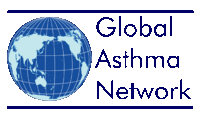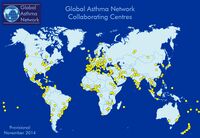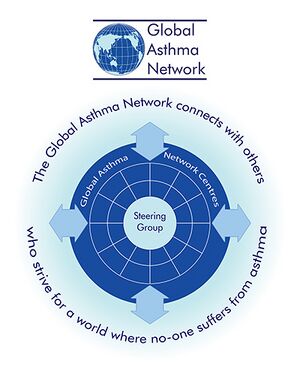Global Asthma Network
Topic: Organization
 From HandWiki - Reading time: 6 min
From HandWiki - Reading time: 6 min
 Global Asthma Network Logo | |
 Distribution of Global Asthma Network centres | |
| Abbreviation | GAN |
|---|---|
| Motto | A world where no-one suffers from asthma |
| Formation | 2012 |
Region served | Global |
Chair | Prof M.I. Asher |
Main organ | Global Asthma Network Steering Group |
| Website | www |
The Global Asthma Network (GAN) is a follow on from the now completed International Study of Asthma and Allergies in Childhood (ISAAC). GAN is a collaboration between former members of ISAAC and members of the International Union Against Tuberculosis and Lung Disease(The Union). GAN is a worldwide network of study centres continuing the global surveillance of asthma in children established by ISAAC, and now including the surveillance of asthma in adults. The network aims to improve asthma care globally, with a focus on low- and middle-income countries, through enhanced surveillance, research collaboration, capacity building and access to quality-assured essential medicines. GAN is responsible for the Global Asthma Report, which is released every three years, the most recently in 2014.[1]
History
In 2012, concern from members of ISAAC and The Union that the Global Non-Communicable Diseases (NCDs) agenda[2] overlooked asthma resulted in the establishment of GAN. GAN is a collaboration between former members of ISAAC, the largest collaborative epidemiological study of children in the world,[3] and members of The Union. The Union and ISAAC collaborated to release the Global Asthma Report at the time of the United Nations High-Level Meeting on Non-Communicable Diseases (NCDs) in New York on 19–20 September 2011.[4] This report provided an overview of what was known about the causes and triggers of asthma, the global incidence, the progress made and the significant challenges currently and for the future. It demonstrated that the suffering and waste of resources caused by not managing asthma effectively are much greater than the cost of effective action. The ISAAC programme formally finished in December 2012. The Global Asthma Network operates on the same principle of collaborative and systematic application of standardised methodologies as the ISAAC programme. The GAN data centre operates from Auckland, New Zealand, communicating methodologies, analysing data, and maintaining the GAN website. The Global Asthma Network has merged the global asthma surveillance work pioneered by ISAAC with the activities that The Union has pursued over the years, including: a) field evaluation and research into the management of asthma, conducted by The Union’s Department of Lung Health and Non Communicable Diseases (NCDs) with in-country partners, b) access to essential medicines, and c) operational research and capacity-building, notably through The Union’s Centre for Operational Research.
- ‘’’Asthma’’’ causes wheezing, and often cough and breathlessness, due to airway obstruction with smooth muscle contraction and airway inflammation. In children, it is most commonly intermittent, but may be persistent. Asthma affects at least 330 million people worldwide, causing an estimated 250,000 deaths annually (all ages). Around 15 million disability adjusted life years (DALYs) are lost annually,[5] and school absenteeism due to asthma results in reduced educational opportunities, and thus impacts on the economy. Based on studies undertaken in developed countries, asthma has been misinterpreted as a westernized problem based on allergy (atopy).[6] Findings from ISAAC[7] and others have shown that the majority of asthma does not have an allergic basis, especially in developing countries where its prevalence is increasing (Africa, Latin America and parts of Asia).[8]
Mission
The Global Asthma Network, under the leadership of the GAN Steering Group, has a vision of ‘a world where no-one suffers from asthma’. The Global Asthma Network’s mission is: To prevent asthma and improve asthma care globally with a focus on low- and middle-income countries. The network will achieve this through enhanced surveillance, research, capacity building, and access to effective asthma care including quality assured essential medicines.
Organization
The Global Asthma Network currently has 280 centres located in 120 countries throughout the world and the number is growing. The GAN Steering Group, consisting of 11 scientists and clinicians selected from The Union and the former ISAAC network, and the smaller Executive Team are responsible for the administration of GAN and its activities. The GAN Steering Group includes members from New Zealand, Switzerland, France, Taiwan, Sudan, Spain, Chile, Australia and the United Kingdom, and many are members of or are advisors to other international bodies. The GAN Steering Group meets quarterly (via Skype) and annually in-person. The GAN Data Centre provides central co-ordination, receives data from GAN centres, and advises at all levels on methodology and other aspects of the programme. The Global Asthma Network has established worldwide networks with organizations concerned with health in developing countries such as the World Health Organization (WHO), the International Union Against Tuberculosis and Lung Disease, the Forum of International Respiratory Societies(FIRS), the International Congress on Pediatric Pulmonology (CIPP), NCD Child and the American Thoracic Society (ATS).
Activities
The Global Asthma Network targets three areas in its aim to improve asthma understanding, prevention and management at the global level.
Global asthma surveillance and research
GAN centres conduct worldwide surveys of (i) asthma symptom prevalence and associated risk factors in children and adults, and (ii) the implementation of management strategies, such as asthma plans and guidelines, in the control of asthma in children and adults. Data compiled from these surveys is included in the three yearly Global Asthma Reports, published in academic journals and presented at international conferences.
Asthma prevention and improving asthma care worldwide
GAN develops strategies for (i) asthma prevention, (ii) asthma management, and (iii) asthma capacity building, particularly in low- and middle-income countries. GAN also aims for improved access to effective asthma care, including quality-assured asthma medications, to all asthma sufferers worldwide.
Advocacy
GAN is lobbying for (i) the inclusion of asthma as a global health priority alongside, and complementary to, the other current global initiatives for the prevention and control of non-communicable diseases,[9] (ii) the inclusion of asthma medicines on all countries’ Essential Medicines Lists, and (iii) the addition of essential asthma medicines to the WHO Prequalification Programme.[10]
Impact
The first of the Global Asthma Network’s three-yearly reports, the Global Asthma Report 2011, highlighted issues surrounding asthma, and provided an overview current knowledge regarding the causes and triggers of asthma, global asthma prevalence, the implementation of management guidelines, and the progress being made. This report has been used in asthma policy development by health organisations around the world, including the WHO,[11] the OECD,[12] The European Respiratory Society,[13] the European Academy of Allergy and Clinical Immunology,[14] and the Government of Australia.[15] It has been cited in numerous research articles[16][17][18][19][20][21] and news articles around the world including Africa, India and Germany[22][23][24][25][26] and has been the subject of editorial comment.[27]
The Global Asthma Network has since produced the Global Asthma Report 2014, which includes updated information on asthma management, the economic burden of asthma, and strategic and practical recommendations.
References
- ↑ Global Asthma Network Steering Group, editor. The Global Asthma Report 2014. Auckland, New Zealand: The Global Asthma Network; 2014.
- ↑ World Health Organization. Comprehensive global monitoring framework and targets for the prevention and control of noncommunicable diseases Geneva, Switzerland: World Health Organization, 2013.
- ↑ Anonymous. Guinness World Records. London: Guinness World Records, Ltd; 2004.
- ↑ The International Union Against Tuberculosis and Lung disease, The International Study of Asthma and Allergies in Childhood (ISAAC), editors. The Global Asthma Report 2011. Paris, France: The International Union Against Tuberculosis and Lung Disease; 2011.
- ↑ Masoli M, Fabian D, Holt S, Beasley R. Global Burden of Asthma. Global Initiative for Asthma (GINA), 2004.
- ↑ Pearce N, Pekkanen J, Beasley R. How much asthma is really attributable to atopy? Thorax. 1999;54(3):268-72.
- ↑ The International Study of Asthma and Allergies in Childhood (ISAAC) Steering Group. The ISAAC Story: Overview of Global Findings New Zealand: The International Study of Asthma and Allergies in Childhood (ISAAC); 2011 [cited 2014 February]. Available from: http://isaac.auckland.ac.nz/story/findings/globaloverview.php.
- ↑ Asher MI, Montefort S, Bjorksten B, Lai CK, Strachan DP, Weiland SK, et al. Worldwide time trends in the prevalence of symptoms of asthma, allergic rhinoconjunctivitis, and eczema in childhood: ISAAC Phases One and Three repeat multicountry cross-sectional surveys. Lancet. 2006;368(9537):733-43.
- ↑ World Health Organization. Action plan for the prevention and control of noncommunicable diseases 2013–2020 Geneva, Switzerland: World Health Organization, 2013.
- ↑ World Health Organization. Prequalification Programme: A United Nations Programme managed by WHO: World Health Organization; 2011 [cited 2015 May]. Available from: http://apps.who.int/prequal/default.htm.
- ↑ Perrin C. Access to essential medicines for asthma. Presentation to the WHO Technical Briefing Seminar on Essential Medicines and Health Products, 28 October - 1 November 2013. Geneva, Switzerland: World Health Organization; 2013.
- ↑ OECD. Health at a Glance: Europe 2012: OECD Publishing; 2012.
- ↑ European Respiratory Society. European Lung White Book. Sheffield, United Kingdom: European Respiratory Society; 2013. ISBN:978-1-84984-043-9.
- ↑ European Academy of Allergy and Clinical Immunology. Global Atlas of Asthma. Akdis CA, Agache I, editors. Zurich, Switzerland: European Academy of Allergy and Clinical Immunology; 2013.
- ↑ Australian Institute of Health and Welfare. A Picture of Australia's Children 2012. Canberra ACT: 2012 Contract No.: PHE 167.
- ↑ Ektah K, Arun RJ, Elza T. Oral findings in asthmatic children. Amrita Journal of Medicine. 2014;10(1):4-8.
- ↑ Mukherjee M, Gupta R, Farr A, Heaven M, Stoddart A, Nwaru BI, et al. Estimating the incidence, prevalence and true cost of asthma in the UK: secondary analysis of national stand-alone and linked databases in England, Northern Ireland, Scotland and Wales—a study protocol. BMJ Open. 2014;4:e006647.
- ↑ Enarson DA. Communicable and non-communicable diseases in children: give them some thought. International Journal of Tuberculosis & Lung Disease. 2011;15(11):1424.
- ↑ Khawaja A, Shahzad H, Kazmi M, Zubairi ABS. Clinical course and outcome of acute severe asthma (status asthmaticus) in adults. Journal of Pakistan Medical Association. 2014;64(11):1292-6.
- ↑ Kraai S, Verhagen LM, Valladares E, Goecke J, Rasquin L, Colmenares P, et al. High prevalence of asthma symptoms in Warao Amerindian children in Venezuela is significantly associated with open-fire cooking: a cross-sectional observational study. Respiratory Research. 2013;14:76.
- ↑ Solé D. Obesity and asthma. Revista Paulista de Pediatria. 2013;31(2):136-7.
- ↑ Call for better management of asthma Sri Lanka: Sunday Observer; 2013 [cited 2014 November]. Available from: http://www.sundayobserver.lk/2013/05/05/fea01.asp.
- ↑ Dwivedi RK. Improving Asthma Care Kashmir: Greater Kashmir; 2013 [cited 2014 November]. Available from: http://www.greaterkashmir.com/news/2013/May/22/improving-asthma-care-10.asp.
- ↑ Mukherjee R. The Global Asthma Report 2011 India: The Times of India; 2012 [cited 2014 November]. Available from: http://timesofindia.indiatimes.com/home/According-to-the-The-Global-Asthma-Report-2011-published-by-The-International-Union-Against-Tuberculosis-and-Lung-Disease-and-International-Study-of-Asthma-and-Allergies-in-Childhood-Asthma-is-the-most-common-chronic-disease-among-children-and-over-23-5-crore-people-around-the-world-are-affected-by-it-which-accounts-for-1-in-every-250-deaths-worldwide-/articleshow/12934158.cms.
- ↑ Ramakant B. Tools to manage Asthma exist, but not reaching many: Report Ghana: Modern Ghana; 2011 [cited 2014 November]. Available from: http://www.modernghana.com/news/351250/1/tools-to-manage-asthma-existbut-not-reaching-many-.html.
- ↑ Wasamu M. Kenya: Asthma Deaths to Increase in the Next 10 Years - WHO Africa: All Africa; 2013 [cited 2014 November]. Available from: http://allafrica.com/stories/201305280117.html.
- ↑ Enarson DA. Still missing the boat for care of people living with asthma: when will we get it right? The International Journal of Tuberculosis and Lung Disease. 2011;14(12):1564.
External links
- Global Asthma Report
- World Health Organization
- ISAAC
- International Union Against Tuberculosis and Lung Disease (The Union)
 KSF
KSF
